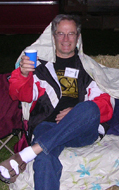- Details
-
Created: Thursday, 02 February 2006 06:31
Editor’s note: We would like to make this a regular Journal column. If you have a photograph of one of your sculptures, along with a drawing or sketch of the original idea, send them in. Don’t worry if the carving doesn’t turn out exactly like the drawing. You can tell us how and why it changed. If you want to see your work featured in BIRTH of a NOTION, send your photos to Terry Slaton or Lane Tompkins.
This first Notion was sent to us by Jim Heltsley
In 2003, Chuck-o Davis and I decided to work on a sculpture together. I went through my drawings and found twelve possible candidates for him to choose from. After some deliberation he picked a design, we decided to use granite, and began the search for a stone that would work. Lakeview Stone provided the black India stair tread. Weighing in at 450 lbs. just getting it to Chuck-o’s was a challenge.
My next task was to enlarge the drawing to match the scale of the stone and make a template to work from. As he began roughing out the initial shape, I worked on refining the details of the design—changing the sharp points to nice curves and trying to use the stone to its full potential.
Once we got the stone shaped to our liking it was apparent that the sculpture needed to be presented at eye level. The original idea for the base had to be changed to accomplish this. Again I went looking for a stone, but had no luck finding one that would work. We went back to the drawing board to design a steel base. A talented metal worker, Dave Lisch, produced just what was needed. Work on “Time in Between” began in February 2003, and was completed in September of that year, taking over 200 hours. It is currently for sale.
What started out as an idea and simple lines in a sketchbook progressed down a path where a piece of stone, the fabrication process, esthetics, and talented artists, all worked together to create a successful sculpture.
- Details
-
Created: Thursday, 02 February 2006 06:29
I did not draw as many young children do. Mud Pies! Now that is where I excelled, out under the trees. Rocks, flowers, and sticks were design materials for decoration. Baked by the sun, and forgotten.
Years passed. I married an artist. Four children arrived. They could draw; I could not. Finally hands asked for creative activity. I remembered Mud Pies. Classes in ceramics began. Hands loved the clay.
Husband gave me a book “History of Modern Sculpture” by Reid. Wonder was born by Brancusi’s “Bird in Space.” Could I possibly find a way to create meaning in so simple a form?
Husband died. A short time later I found myself in a sculpture class. What was I doing there? I could not draw. Hands were happy when the teacher had us begin rasping on a soft stone.
My interest has always been centered on the “Hidden side of Nature” - Life within the form. My first real sculpture was a pile of rocks in one form. People stopped asking me to draw.
Inspiration has come from many places: a sculptor in a novel, great teachers, books, videos, Ichida’s “Roundness of Horizon” at the U. of O. museum, and the discovery of NWSSA symposia.
The last time I was at Camp Brotherhood I told Boris Spivak I could not draw. He stood at the table, pointed at me and said: “You do draw. You draw on your stone.”
Life is complete, and I’m still learning.
 Need a quick gift this time of year? Get a piece of floor tile, and epoxy on some fancy knobs from the cabinet section of your local hardware store, and you have a nice trivet. Some easy polishing with sanding discs can make it really spiffy. Pull a hand truck if the load is tall. Running into a small bump, while pushing, can halt the cart and dump the load. Bummer. When drilling through a stone, remember that the drill will blow out the edges as it exits. Be sure the Velcro discs are firmly attached to the backing pad. Trying to find the green one in the grass after it sails off can take some time. Keep your power cords away from the cutting edge. Don’t tempt a fire with oily rags tossed haphazardly around. Scissors can sometimes function as tweezers. There is an inverse ratio between the desirability of a rough stone and its estimated weight. Make sure the address on an envelope is correct before putting on the stamp.
Need a quick gift this time of year? Get a piece of floor tile, and epoxy on some fancy knobs from the cabinet section of your local hardware store, and you have a nice trivet. Some easy polishing with sanding discs can make it really spiffy. Pull a hand truck if the load is tall. Running into a small bump, while pushing, can halt the cart and dump the load. Bummer. When drilling through a stone, remember that the drill will blow out the edges as it exits. Be sure the Velcro discs are firmly attached to the backing pad. Trying to find the green one in the grass after it sails off can take some time. Keep your power cords away from the cutting edge. Don’t tempt a fire with oily rags tossed haphazardly around. Scissors can sometimes function as tweezers. There is an inverse ratio between the desirability of a rough stone and its estimated weight. Make sure the address on an envelope is correct before putting on the stamp.



